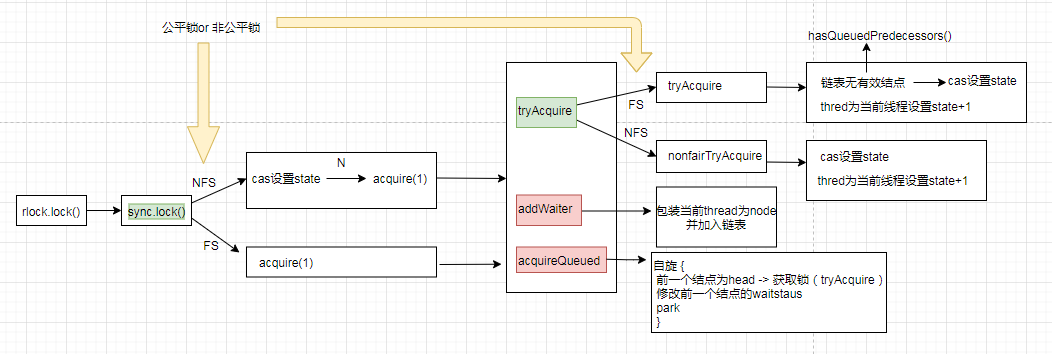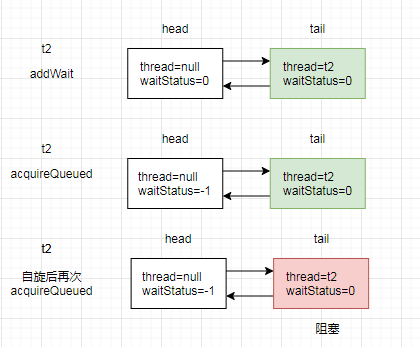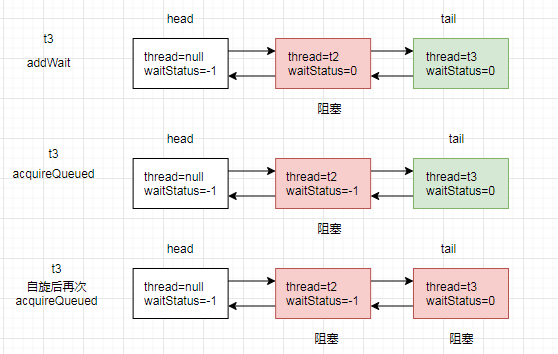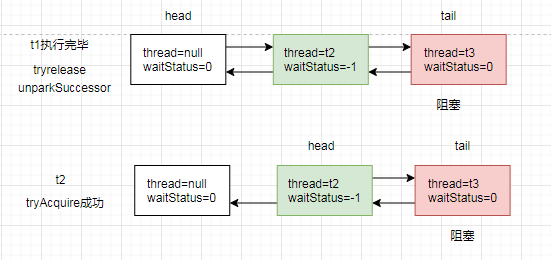ReentrantLock
ReentrantLock流程
测试代码
main方法中通过new ReentrantLock();创建了一个可重入锁,然后通过线程池创建了5个线程,在各个线程中通过rlock.lock();进行加锁,然后执行逻辑,最后通过rlock.unlock();进行解锁。代码如下:
import java.util.concurrent.ExecutorService;
import java.util.concurrent.Executors;
import java.util.concurrent.locks.ReentrantLock;
public class ReentrantLockTest {
public static volatile int count = 0;
public static void main(String[] args) throws InterruptedException {
// ReentrantLock rlock = new ReentrantLock(true);
ReentrantLock rlock = new ReentrantLock();
ExecutorService executorService = Executors.newFixedThreadPool(5);
for (int i = 0; i < 5; i++) {
executorService.execute(()->{
rlock.lock();
System.out.println(Thread.currentThread().getName()+ " start");
for (int j = 0; j < 10; j++) {
System.out.println(Thread.currentThread().getName()+ " " +count++);
}
System.out.println(Thread.currentThread().getName()+ " end");
rlock.unlock();
});
}
Thread.sleep(5000);
System.out.println(count);
}
}
上锁流程

说明:ReentrantLock 调用lock时,若为非公平锁先直接通过cas设置state的状态,若设置失败,在调用acquire,acquire会先调用tryAcquire(AQS子类实现),线程会尝试通过cas设置状态,若失败,将thread封装成Node加入到队列(CLH队列)中,然后调用acquireQueued,acquireQueued中会自旋,判断前一个结点是否为head,若为则通过tryAcquire获取锁,若失败去修改前一个结点的waitstatus,挂起当前线程。

说明:ReentrantLock 调用unlock时,然后调用release,而release通过tryRelease来设置state状态,并设置线程为null,最后unpark后面的结点。
代码说明
上锁相关代码
// ReentrantLock
public void lock() {
sync.lock();
}
// ReentrantLock#NonfairSync
final void lock() {
if (compareAndSetState(0, 1))//若通过CAS设置变量State(同步状态)成功,也就是获取锁成功,则将当前线程设置为独占线程
setExclusiveOwnerThread(Thread.currentThread());
else
acquire(1);// 存在某种排队等候机制,线程继续等待,仍然保留获取锁的可能,获取锁流程仍在继续
}
// ReentrantLock#FairSync
final void lock() {
acquire(1);
}
// AbstractQueuedSynchronizer
public final void acquire(int arg) {
//去尝试获取锁,获取成功则设置锁状态并返回true,否则返回false。tryAcquire尝试获取锁,子类实现
if (!tryAcquire(arg) &&
//如果tryAcquire返回FALSE(获取同步状态失败),则调用该方法将当前线程加入到CLH同步队列尾部。
acquireQueued(addWaiter(Node.EXCLUSIVE), arg))
//acquireQueued:当前线程会根据公平性原则来进行阻塞等待(自旋),直到获取锁为止;并且返回当前线程在等待过程中有没有中断过。
selfInterrupt();
}
// ReentrantLock#FairSync
protected final boolean tryAcquire(int acquires) {
final Thread current = Thread.currentThread();
int c = getState();
if (c == 0) {
// 若队列中无有效结点才进行cas操作拿锁,非公平锁无需判断hasQueuedPredecessors
if (!hasQueuedPredecessors() &&
compareAndSetState(0, acquires)) {
setExclusiveOwnerThread(current);
return true;
}
}
else if (current == getExclusiveOwnerThread()) {
int nextc = c + acquires;
if (nextc < 0)
throw new Error("Maximum lock count exceeded");
setState(nextc);
return true;
}
return false;
}
// 是公平锁加锁时判断等待队列中是否存在有效节点的方法。如果返回False,说明当前线程可以争取共享资源;如果返回True,说明队列中存在有效节点,当前线程必须加入到等待队列中。
public final boolean hasQueuedPredecessors() {
Node t = tail;
Node h = head;
Node s;
// 双向链表中,第一个节点为虚节点,其实并不存储任何信息,只是占位。真正的第一个有数据的节点,是在第二个节点开始的。
// 当h != t时: 如果(s = h.next) == null,等待队列正在有线程进行初始化,但只是进行到了Tail指向Head,没有将Head指向Tail,此时队列中有元素,需要返回True。
// 如果(s = h.next) != null,说明此时队列中至少有一个有效节点。如果此时s.thread == Thread.currentThread(),说明等待队列的第一个有效节点中的线程与当前线程相同,那么当前线程是可以获取资源的;
// 如果s.thread != Thread.currentThread(),说明等待队列的第一个有效节点线程与当前线程不同,当前线程必须加入进等待队列。
return h != t &&
((s = h.next) == null || s.thread != Thread.currentThread());
}
关于FairSync和NonfairSync中tryAcquire
// FairSync
protected final boolean tryAcquire(int acquires) {
return nonfairTryAcquire(acquires);
}
// Sync
final boolean nonfairTryAcquire(int acquires) {
final Thread current = Thread.currentThread();
int c = getState();
if (c == 0) {
if (compareAndSetState(0, acquires)) {
setExclusiveOwnerThread(current);
return true;
}
}
else if (current == getExclusiveOwnerThread()) {
int nextc = c + acquires;
if (nextc < 0) // overflow
throw new Error("Maximum lock count exceeded");
setState(nextc);
return true;
}
return false;
}
// FairSync
protected final boolean tryAcquire(int acquires) {
final Thread current = Thread.currentThread();
int c = getState();
if (c == 0) {
if (!hasQueuedPredecessors() && // 若队列中无有效结点才进行cas操作拿锁
compareAndSetState(0, acquires)) {
setExclusiveOwnerThread(current);
return true;
}
}
else if (current == getExclusiveOwnerThread()) { // 可重入锁
int nextc = c + acquires;
if (nextc < 0)
throw new Error("Maximum lock count exceeded");
setState(nextc);
return true;
}
return false;
}
看以上代码可以发现FairSync和NonfairSync中tryAcquire实际上只有一行代码是不同的,公平锁多了一个队列中是否存在有效结点的判断!hasQueuedPredecessors(),可以考虑到模板方法把可变的这一行提出来或者直接判断带对象是否是非公平锁。
// Sync
protected final boolean tryAcquire(int acquires) {
final Thread current = Thread.currentThread();
int c = getState();
if (c == 0) {
// 是非公平锁或无有效结点 才进行cas操作拿锁
if ((this instanceof NonFairSync || !hasQueuedPredecessors()) &&
compareAndSetState(0, acquires)) {
setExclusiveOwnerThread(current);
return true;
}
}
else if (current == getExclusiveOwnerThread()) { // 可重入锁
int nextc = c + acquires;
if (nextc < 0)
throw new Error("Maximum lock count exceeded");
setState(nextc);
return true;
}
return false;
}
解锁相关代码
// ReentrantLock
public void unlock() {
sync.release(1);
}
// AbstractQueuedSynchronizer
public final boolean release(int arg) {
// 释放锁成功后则执行后面的唤醒后续节点的逻辑了
if (tryRelease(arg)) {
Node h = head;
// addWaiter 方法默认的节点状态为 0,此时节点还没有进入就绪状态
if (h != null && h.waitStatus != 0)
unparkSuccessor(h);
return true;
}
return false;
}
// ReentrantLock#Sync
protected final boolean tryRelease(int releases) {
int c = getState() - releases;
if (Thread.currentThread() != getExclusiveOwnerThread())
throw new IllegalMonitorStateException();
boolean free = false;
if (c == 0) {
free = true;
setExclusiveOwnerThread(null);
}
setState(c);
return free;
}
private void unparkSuccessor(Node node) {
/*
* If status is negative (i.e., possibly needing signal) try
* to clear in anticipation of signalling. It is OK if this
* fails or if status is changed by waiting thread.
*/
int ws = node.waitStatus;
// 将头节点的状态设置为0, 尝试清除头节点的状态,改为初始状态
if (ws < 0)
compareAndSetWaitStatus(node, ws, 0);
/*
* Thread to unpark is held in successor, which is normally
* just the next node. But if cancelled or apparently null,
* traverse backwards from tail to find the actual
* non-cancelled successor.
*/
// 后继节点
Node s = node.next;
// 如果后继节点为null,或者已经被取消了
if (s == null || s.waitStatus > 0) {
s = null;
// for循环从队列尾部一直往前找可以唤醒的节点
for (Node t = tail; t != null && t != node; t = t.prev)
if (t.waitStatus <= 0)
s = t;
}
if (s != null)
// 唤醒后继节点
LockSupport.unpark(s.thread);
}
例子说明
开头例子启动了5个线程(t1,…t5),启动后他们会去争抢锁,假设t1最先lock,他通过cas操作拿到了锁(假设长时间占用),然后t2(可能是其他线程)在取lock时会失败,然后调用acquire,会再次去获取锁,又失败了,就会将t2封装成一个Node对象,将其加入到队列中,然后在调用acquireQueued,此时t2为第一个结点,会再次去获取锁,若失败,修改前一个结点(head)的waitstatus=-1,自旋再次调用一遍,此时前一个结点的waitstaus=-1,故阻塞改线程。



参考:
https://mp.weixin.qq.com/s/jCBrHSVK647bdVIPvJHxOg
https://tech.meituan.com/2019/12/05/aqs-theory-and-apply.html